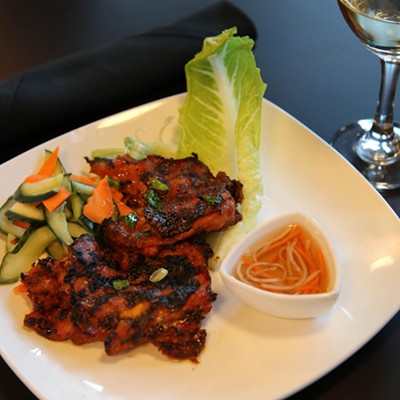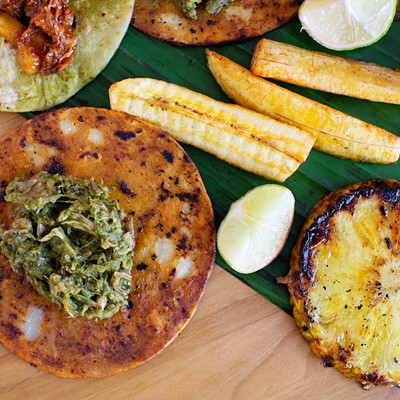It was both our server's and the hostess' first day when we stopped in at Fuku Sushi on a quiet Sunday evening. To be fair, I'll refrain from commenting on the service during this visit.
We were seated at a table next to the floor-to-ceiling window that makes up the exterior wall. The wall allows for great people-watching along University Boulevard. The rest of the décor is smartly simple: Pale purple, almost-grey walls are accented with brown, black and white. There are small tables, high tables and half-booths. A sushi bar dominates the center of the room.
The training server explained that menu was in transition, so several items weren't available. That's no problem as long as the diner knows ahead of time.
We ordered an appetizer of calamari ($8), and for entrées, John ordered the shrimp teppan-yaki ($9.50 plus $1 for the fried-rice option), and I ordered shrimp nigiri ($4), tuna nigiri ($4) and the honor roll ($8), one of many house, or "Fuku style," rolls. Although there was a nice assortment of beer, wine and mixed drinks, we stuck to water.
The miso soup and green salad that come with the meals arrived first. Both were good-sized portions; while the soup was flavorful, the salad was a bit wilted and could have used a tad more of the soy-sauce-based dressing.
Rings of crumb-coated calamari followed. The coating had a nice crispiness, and the calamari was tender. The Japanese mayo dip was almost unnecessary, but still complemented the food nicely.
The nigiri was passable, but I've had better at other restaurants around town; however, John enjoyed his teppan shrimp. Like the calamari, the shrimp was cooked perfectly, and the savory soy-influenced sauce was quite good. Sadly, the dish was lukewarm, which lessened the overall impact.
My honor roll was clever in both presentation and flavor. Crab mix, avocado, cucumber and kaiware (daikon and beet) sprouts had been rolled in nori and rice, and topped with spicy tuna; the roll was then sliced and stacked haphazardly. There was a crunch sprinkled on top. Artful swirls of spicy mayo and eel sauce graced the plate and added another layer of flavor. I would order it again (but only after trying several of the other house rolls).
One irritation: the music. Granted, these tunes aren't on my playlist, but it was uncomfortably loud.
My friend Miranda was in town and served as my dining companion for another dinner visit, about a week later. The music was a tad softer, but still a bit over the top.
We had the same server, on his own this time. He tried hard and was incredibly pleasant, but he didn't know the answers to several questions. To his credit, he did go and ask, returning to the table with all the correct answers.
One of our questions concerned the ginger margarita ($6) that Miranda ordered. The menu said it had Cointreau, fresh lime juice, sweet-and-sour mix, and Canton, with the glass trimmed out in both sugar and salt. We asked what Canton was twice and were told it is a ginger-infused liqueur. Research confirmed that; apparently, it was once a big hit in French Indochina. My choice of beverage was a large bottle of Sapporo ($4).
The menu revamp had been completed, with some changes, especially when it came to appetizers (a few sushi changes and some higher prices). We ordered the Japanese fish tacos ($3.75 happy-hour price; regularly $7) and the honey fries ($2.50 at happy hour; $5 normally).
Both were a hit. For the tacos, small flour tortillas were wrapped around crispy tempura-battered white fish. Finely shredded strips of cabbage and a slick of mayo sat atop.
The honey fries were actually sweet-potato fries served with the house "secret sauce." The food detectives that we are, Miranda and I dissected the ketchup-based dip. Miranda tasted Sriracha, and I decided that the chunks were jalapeño with a dash of their juice. Anyway, it was a surprise complement to the crispy fries. Japanese food is obviously more than a plateful of raw fish, and the Fuku folks have a good handle on frying foods.
For the entrées, we ordered a few traditional rolls: a caterpillar roll ($9.50), a rainbow roll ($9.50), and a Fuku tiger roll ($8.50): cucumber, spicy tuna and avocado, topped with tuna and salmon.
When the miso and salad arrived, there was a noticeable difference from the first visit: a smaller bowl of miso but without tofu or veggies; and a fresher, better-dressed salad.
We were almost sated by the time the sushi arrived. While the rolls were quite good, none really popped. What was missing was ... umami. The creamy texture was there, as was the crunchiness of the cucumber, the saltiness from the eel sauce and the faint sweetness of the sticky rice--but there was none of that mouthwatering, deep flavor that can make sushi so addictive.
Nonetheless, the folks at Fuku Sushi seem to have a good sense about what it takes to be successful. They are putting out some good food; prices are reasonable; they're working on the service. In other words, they deliver.
This address has been the site of several failed restaurants over the years and another that suffered a fire. "Fuku" in Japanese has many meanings including "crawl," "clothes" and "good fortune."
In all sincerity, we wish "Fuku" to Fuku Sushi.








